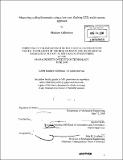Measuring cycling kinematics using a low-cost, flashing LED, multi-camera approach
Author(s)
Gilbertson, Matthew (Matthew W.)
DownloadFull printable version (37.07Mb)
Other Contributors
Massachusetts Institute of Technology. Dept. of Mechanical Engineering.
Advisor
David J. Willis.
Terms of use
Metadata
Show full item recordAbstract
In this thesis a low cost motion capture approach is presented and applied to measure cyclists' kinematics. The motion capture system consists of low cost hardware and custom developed software. Based on still-frame, off-the-shelf digital cameras, the method represents a solution which is accessible to the average athlete. With the exception of off-the-shelf digital cameras the total cost of the hardware is less than $100. The motion capture system is applied to study cyclist kinematics for three different types of bicycles: road bikes, triathlon bikes, and mountain bikes. Coupled with power output measurement and wind tunnel drag measurements, the investigation of several different standard cycling positions is performed. The results indicate a significant component of out-of- plane joint motions, especially in the knee, with an average knee excursion between 0.15" and 0.21". The system was also used to measure cycling cadence, with a range between 1.06Hz and 1.63Hz. Joint angle analysis suggested a positive correlation between ankle angle range and power output. Further in-depth analyses of these data or similar data collected using these motion capture approaches may give deeper insight into which motions correlate with higher power outputs. Wind tunnel and power data were used to calculate position transition velocities for different exertion levels and hill angles. This low-cost system was demonstrated to be a useful and effective tool for measuring and analyzing cycling kinematics.
Description
Thesis (S.B.)--Massachusetts Institute of Technology, Dept. of Mechanical Engineering, 2008. Includes bibliographical references (p. 60).
Date issued
2008Department
Massachusetts Institute of Technology. Department of Mechanical EngineeringPublisher
Massachusetts Institute of Technology
Keywords
Mechanical Engineering.